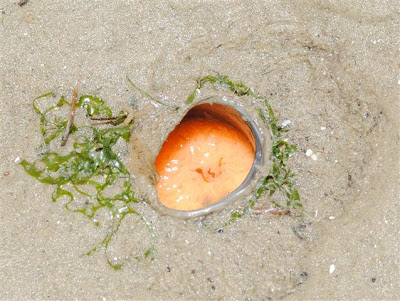After about one year of absence from the intertidal shores of Chek Jawa, I had the honour to be back here again this time with Dr Dan and his students!
Every year, Dr Dan leads a group of students from the Duke University's Nicholas School of the Environment on an Urban Tropical Ecology in Singapore trip and will never fail to share Chek Jawa to his students.
Since Dr Dan and I have not been down to the shores for a year, we could very quickly figure how much the shore has changed! Other than the ever-shifting sand bar, we noticed something delightful... the Carpet anemones (Stichodactyla haddoni) seem to be coming back slowly but surely.
Here is an assortment of the different carpet anemones with different colours. They used to be so common and abundant before the mass death in 2007 such that they look like landmines on the sandbar.
Some of these carpet anemones have settled well among the lush seagrasses of Chek Jawa.
We saw many juvenile carpet anemones on the sand bar and this is a good sign!
One Common sea star (Archaster typicus) was found during the trip. I did not really have the opportunity to look for the colony of them on the sand bar as the tide was not very low.
Buried or semi-buried on the sand bar are sea cucumbers and sea stars such as this Smooth sea cucumber and the Plain Sand star (Astropecten indicus).
We stumbled across this dead plain sea star with lots of snails feasting on it. This of course is not a result of any physical stress such as drop of salinity but a natural occurence of feeding / scavenging on dead animals.
I got the sense from this trip that the number of Cake sand dollars (Arachnoides placenta) on the sand bar has dropped. It could be because that the tide was not that low. We noticed many pecked sand dollars with the star-shaped jaw exposed. These sand dollars were recently predated on by shorebirds.
We tried to look for the Button snails (Umbonium vestiarum) and after a while, Ria shared with everyone that she has found live ones on the sand bar! The density of these snails are not high but these snails seem to be bigger than usual. We also found one Lined moon snail (Natica lineata) which is actually a predator of the button snails.
Dr Dan found a rare snail! This is the Naked moon snail (Sinum sp.) which I think has not been sighted at Chek Jawa before.
The mantle of this snail is such that it cannot fully retract back into its flat thin shell. It sure can stretch itself and elongate quite a fair bit!
The empty shell of a Tun snail (Family Tonnidae) was spotted! Are living ones lurking somewhere out there?
Cindy found this large shell of a Bonnet snail (Phalium glaucum) that is occupied by a hermit crab. The living version of this snail is actually rare and not commonly sighted.
This is an interesting view of the cerianthid which is also known as peacock anemone. The cerianthid actually lives within a tube which is visible in this photo from top down position.
We came across this washed up Common sea pen (Pteroides sp.) with a porcelain crab living within. It was found quite high up near the mangroves.
Surprise surprise! It was great to spot the dugong feeding trails again!
Here's Dr Dan with his students having a closer look at the trails. The trail seem to suggest that two dugongs were feeding on the seagrass together!
Before we left, we had an aerial view of the shore from the tall Jejawi Tower.
It was indeed wonderful to be back at Chek Jawa to see how it is recovering since the mass death. As for now, I do really hope to be back on a super low spring tide to check out the coral rubble. My previous check up on this fragile but rich habitat was in 2009.



















No comments:
Post a Comment